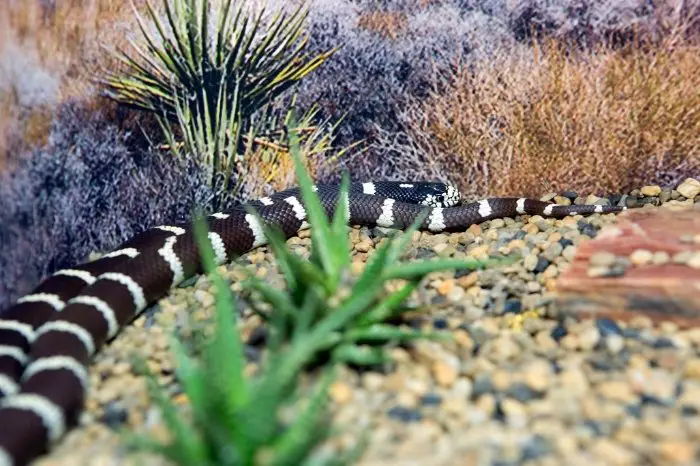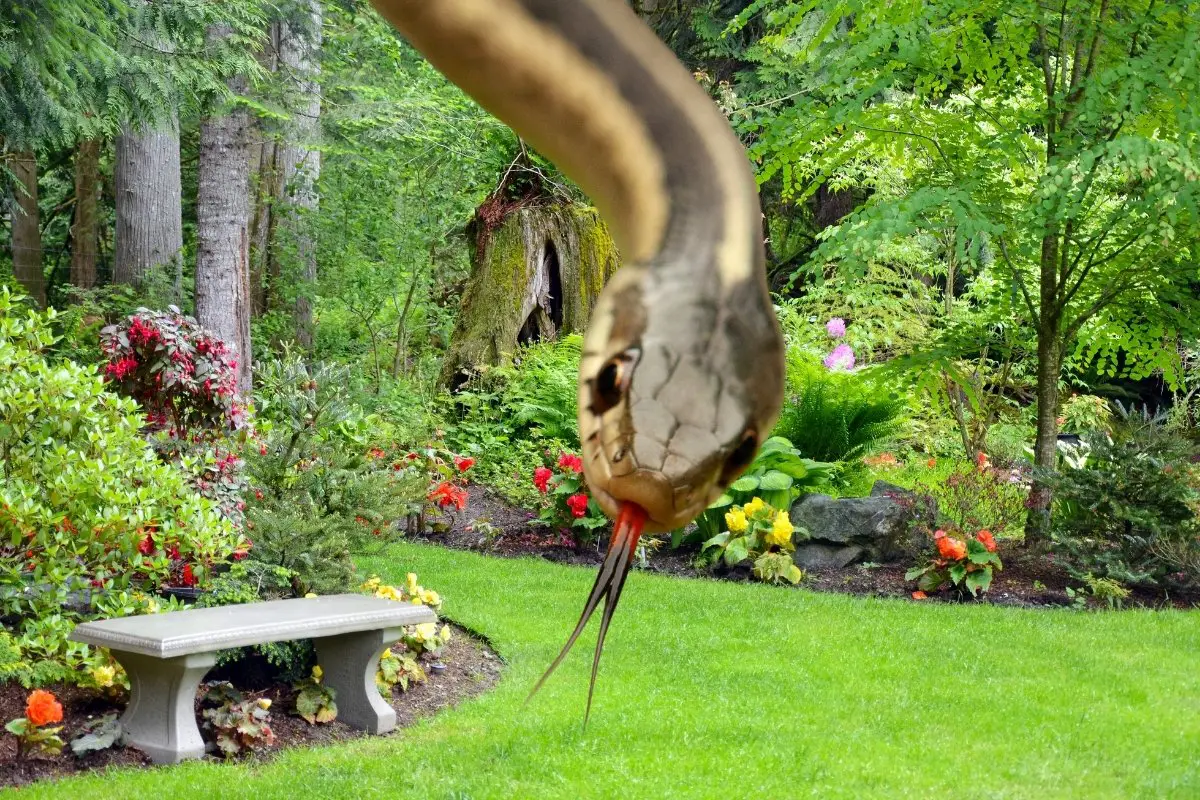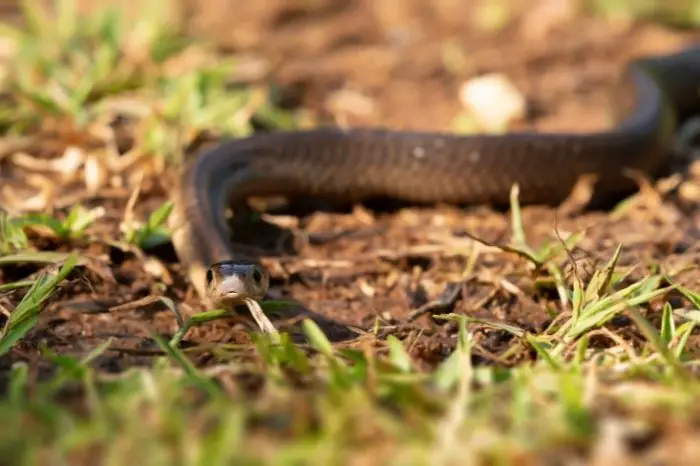Last Updated on March 2, 2023 by Griselda M.
You might find many animals in your garden, including snakes, making gardeners wonder about snakes in the garden meaning. On a positive note, snakes are carnivores, meaning that they only eat meat. You don’t have to fear that a snake will eat any of your plants. In today’s article, we’ll be taking a look at what exactly the presence of snakes in your garden means and determine whether it’s good or bad.
Are Snakes Good For The Garden?
Unlike other animals, such as deer or rabbits, snakes are great for your garden! Most snakes are near the bottom of the food chain, as they mostly feed on small vermin and sometimes insects. Because of this, they can only be beneficial for your garden. A single snake can destroy a colony of grasshoppers in a single summer!
Additionally, snakes aren’t going to deal any damage by burrowing, either. Although snakes are known to make holes in the ground, they’re much happier to use holes that belong to other animals. That means that they’ll clear out moles and mice in your area. Once these animals notice a snake around or in their tunnels, they’ll hastily evacuate.
Snakes will also eat snails and slugs, which are a particularly gruesome enemy of any plant.
Check Out How To Make Bird Food At Home
What to Do With a Garden Snake?
So, now that you know that the snake doesn’t pose any danger to the garden itself, you might be wondering what you do if you see a snake in your garden. The best piece of advice we can give you is to leave it alone. It’d be great if you could identify the snake. If you notice a garter snake, which is a non-venomous and extremely common snake, just back away.
The snake isn’t interested in you at all and it’s most likely frightened at the sight of you. The largest number of snakes won’t attack you in any way unless you step on them, try to pick them up, or if you corner them. Aggressive snakes that will actively start trouble are very rare. The Black Mamba, for example, is a very aggressive snake – but it lives only in a few places in Africa.
When you notice a snake, remember what it looks like and find out what snakes live in your area. If you identify it and it’s a venomous snake, call the local vet to ask for help – it’s not safe to keep that sort of snake around. Even though it would most likely leave on its own after a few days, it’s still better to be safe than sorry.
If the species you find in your garden is non-venomous, though, and it isn’t dangerous – feel free to leave it there. Although the same rule applies – the snake likely won’t stay for long. It will stay in your garden as long as the temperature suits it and there’s food. Even in this scenario, though, it’d be wise to call the local vet and ask for their opinion.
Victor VP364B Snake-A-Way Snake Repelling Granules – 4 LB
While you’re working in your garden, the snake will always move away if you’re near. However, make sure that you know what you’re touching while you’re touching it. Due to their shape, snakes can easily be mistaken for something else.
Read more about How To Scare Skunks Away Without Getting Sprayed
What Attracts Snakes to Your Garden?
Snakes need several things to thrive in an environment; shelter, enough sun, and enough shade, a source of food, and water. If there’s a snake in your garden for a longer period, that means that there’s plenty of food for it there. You should be happy about this because that means that the snake will eat all that food!
If you’re looking to attract a snake to your garden, first check whether you live in an area with snakes. Snakes will often avoid areas that are too cold or too hot as it’s not safe for them – and it’s not like you can change the temperature. Then, a snake will need a source of water.
You can provide this by creating a shallow fountain or a pond. Then, if there are natural bushes, the snake will likely use them as shelter.
Lastly, it’s important to understand that snakes have a sense of smell that’s unimaginably stronger than our own. They can smell virtually anything, and that includes herbicides and pesticides. Even though they might not harm the snake itself, they’ll certainly sense its presence and avoid it.
What also counts is that a pesticide will likely kill all possible sources of food for the snake, so it will likely stay hungry if you’re using chemicals to kill pests.
If you want a snake in your garden, that garden has to be organic!
Click Here to Learn About:
Most Common Snakes in Gardens
Possibly the most common snake in gardens is the garter snake. There are many subspecies of this snake and it’s present across most climate zones on Earth. They primarily feed on slugs, large insects, and small rodents. They’re completely harmless to you, as they’re small and non-venomous. However, they’re very dangerous for your average mouse! Because of this, a garter snake can often be a gardener’s best friend!
We should also mention the King Snake. These snakes are one of the few snake species that are immune to venom! They’re also incredibly strong and some herpetologists consider them to be the strongest constrictor, relative to their size. The King Snake can be very beneficial to your garden, as they’ll eat basically anything that they can fit into their mouth!

Copperhead Baby Garter Snake – Specifications
So, is there a Copperhead baby garter snake? I have found that a lot of people search for information about this snake but actually do so in confusion. This is because a copperhead baby snake and a garter snake are two completely different species. A Copperhead snake’s head is similar to that of a copper penny. A gardener or garter snake, as it is commonly known, is actually quite different in appearance, behavior, and other aspects compared to the copperhead.
These snakes are actually beneficial to have in your yard as it rids of pests. The garter snake is also not much of a nuisance to the homeowner as it is known to stay hidden for the most part. Let’s have a look at the differences between these two specimens.
Garter Vs Copperhead Snake Specifications:
Garter Snake:
- Family – Colubridae
- Species – Thamnophis sirtalis, which is a common garter snake.
- Region – North America, which is dependent on the species.
- Size – From 18 to 42 inches in length.
- Appearance – The garter snake has round pupils and a stripey pattern on its body. It comes in a variety of colors which include green, black, and brown.
- Hunting tactics – This snake relies on vision and scent to catch its prey. Ambushing, craning, and peering are also part of a successful hunt.
- Venom strains – Garter snakes are very mildly venomous, so they aren’t harmful. After a snake bite from one of them, you will experience swelling, bruising, and some moderate pain.
Copperhead Snake:
- Family – Viperidae
- Species – Agkistrodon contortrix
- Region – Depending on the subspecies, these snakes inhabitant the central and Eastern parts of the United States.
- Size – From 22 to 36 inches in length.
- Appearance – Vertically slit pupils, brown and copper colored hues, cross bands on the body that are hourglass-shaped.
- Hunting traits – These snakes rely on their senses when hunting. They hunt by scent, heat projected by pit organs, and vision.
- Venom strains – Copperhead snakesare venomous. If bitten by one, you will experience lethargy, fever, hemorrhage, edema, and pain. However, these snake bites don’t commonly result in the death of humans.
What Does a Garden Snake Look Like?
Ever wondered what does a garden snake look like? Most garden snakes are harmless; therefore, it is essential to positively identify them instead of unnecessarily getting startled. These snakes usually have markings along the length of their body in a yellow, white, or red coloring. They don’t grow very large and are about 0.5 to a meter in length. However, if you look at garter snakes in the Florida region, you would find that most of these garden dwellers are blue, while regions like Texas houses checkered varieties that are night crawlers.
But what about the brown garden snake? These snakes are easily identified by their reddish-brown scales that appear uniformly along their bodies. As they become older, the coloring darkens and becomes a distinctive brown with streaks of yellow along its head. Brown house or garden snakes, known by their scientific name, Storeria, are found in the North American parts of the US. These snakes are typically harmless as they don’t have venom or fangs. Instead, their teeth and jaws are meant to assist them in consuming their prey.
How Did the Garter Snake Get Its Name?
So, how did the garter snake get its name? The garter snake interestingly got its name from the garter belt. This is because it resembles the fabric that is usually used to secure a sock or stocking when it’s worn on the leg. There are several theories as to how these common North American snakes got their name.
However, it makes sense that it was acquired because of their distinct similarities in pattern to that of a stocking garter. If you spot one in your garden, don’t be afraid to get a good look at them from a reasonable distance to see why they are called garter snakes in the first place.
Do Garter Snakes like Water?
Do garter snakes like water? The answer is yes, garter snakes like areas that are waterlogged and grassy. This is why these snakes are commonly found near lakes, streams, and other water sources that are accessible to them. Depending on the climate in your region, you should keep in mind that extremely hot weather steers these snakes toward cooler vegetation that is moist.
If you have a garter snake as a pet, then the best habitat would have an ideal temperature of 75 to 85 F. Aside from water-swamped areas, garter snakes are also attracted to rocky areas if the temperatures are right.
Snakes in The Garden – Conclusion
To sum up, snakes are definitely good for your garden! These animals are incredible tools when it comes to the control of pests and vermin. Most snakes you’ll come across in your garden are completely harmless, but it’s best to keep your distance until you identify the exact species. Make sure you call the vet or animal control and ask for advice.
A non-venomous snake, however, can be a very powerful ally for the upkeep of your garden. Insects and vermin will definitely stay away if they know that there’s a snake in the garden!
Learn more about the Causes Of Snake Plant Mushy Leaves and 5 Critical Signs To Watch Out For




